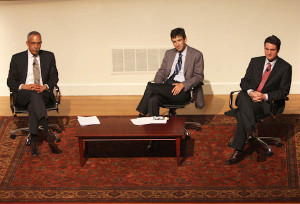Claude Steele, dean of the School of Education, spoke about the concept of “stereotype threat,” which he developed largely through his own research, at the 79th annual Cubberley Lecture Thursday evening.
“You can find [stereotype threat] virtually anywhere you look,” Steele said. “There is no group for which there is not a negative stereotype.”

Stereotype threat is defined as a feeling of anxiety in a situation where a person has the potential to conform to a negative stereotype about his or her social group, whether that is race, gender, socioeconomic class or any other aspect of identity.
Almost 400 audience members crowded into Cubberley Auditorium to listen to Steele present with two other researchers, Geoffrey Cohen Ph.D. ‘98, a professor in the School of Education and the psychology department, and Greg Walton ‘00, an assistant professor of psychology, who shared more current research on stereotype threat.
To illustrate the idea of stereotype threat to the audience, Steele showed a clip from Eminem’s biographical movie “8 Mile.” In the scene, Eminem freezes up before the crowd because he feels threatened at a rap battle where he is the only white person in the club.
“That was a rough day for Eminem,” Steele said.
Walton presented another famous example of stereotype threat. He read a senior thesis written by Michelle Obama, who was a Princeton student in 1985.
“‘It often seems as if, to them [white students and professors], I will always be black first and a student second,’” Walton said, quoting Obama.
Steele said that understanding stereotype threat could help to diminish the achievement gap between different races in the classroom.
“It isn’t the entire bulk of the achievement gap,” he said, “but it’s a big part.”
Steele cited one of his famous experiments done on stereotype threat, which found that, on average, African American students scored one standard deviation lower than white students on an IQ test. However, when African American students were told that the test was a puzzle, rather than a test of intellectual ability, the gap disappeared.
“Your intelligence is not on the line in a puzzle…it’s your response to that stereotype that gets you distracted and prevents you from doing well on that test,” Steele said.
If there is no perceived stereotype or if the person does not care about performance in the given area, they will not be affected by stereotype threat, according to Steele.
“What is interesting about stereotype threat is that what makes you vulnerable is being invested in the domain where your group has a negative stereotype,” Steele said.
After describing the phenomenon of stereotype threat and giving examples of how it can be detrimental in the classroom, Steele, Cohen and Walton described various possible solutions to the phenomenon.
The first and most important way to reduce the effects of stereotype threat, Steele said, is to reduce legal and societal barriers to certain identity groups. Steele gave several examples of these barriers, including Jim Crow-era segregation and bans on same-sex marriage.
He also said that an important way to combat stereotype threat is to develop a “critical mass” of people who share an identity, because it is easier for people to combat prejudice in groups.
Affirmative action, Steele said, is an important step in developing critical masses for minorities on college campuses.
Walton said that another important way to combat stereotype threat is to make minority students feel like they belong at school. In an experiment that Walton and Cohen performed with a group of college freshmen, they found that freshmen performed better if they knew how much their peers had struggled to find a place at college.
Cohen said that while the techniques implemented by the experimenters did have a significant impact on the performance of the students in question, they did not have to be implemented by scientists.
“These interventions sent the exact same message as valuable teachers send to their students every day,” said Cohen.